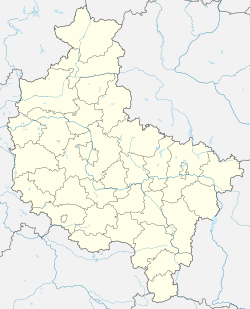Zbąszyń
Zbąszyń [ˈzbɔ̃ʂɨɲ] (German: Bentschen) is a town in western Poland, in Greater Poland Voivodeship, in Nowy Tomyśl County. It is the administrative seat of Gmina Zbąszyń.
Zbąszyń | |
|---|---|
 | |
 Flag  Coat of arms | |
 Zbąszyń  Zbąszyń | |
| Coordinates: 52°15′11″N 15°55′4″E | |
| Country | |
| Voivodeship | |
| County | Nowy Tomyśl |
| Gmina | Zbąszyń |
| Area | |
| • Total | 5.57 km2 (2.15 sq mi) |
| Population (2006) | |
| • Total | 7,300 |
| • Density | 1,300/km2 (3,400/sq mi) |
| Postal code | 64-360 |
| Website | http://www.zbaszyn.pl |
Geography
The town is situated on the Obra river in the Greater Poland historic region, about 75 km (47 mi) west of Poznań. Gmina Zbąszyń is part of the Polish-German Pomerania Euroregion
History
While the earliest mentions of the settlement date back to 1231, the name Sbansin first appeared in a 1277 deed, issued by Duke Przemysł I of Greater Poland at his Poznań residence. Its citizens received town privileges before 1311, making Zbąszyń one of the oldest towns in Poland. It was held by the Polish monarchs until in 1393 King Władysław II Jagiełło ceded it to his Masovian governor Jan Głowacz of Nałęcz. By the early 15th century, Zbąszyń evolved as a centre of the Greater Polish Hussite movement.
As a result of the Second Partition of Poland in 1793 it became part of the Kingdom of Prussia and was administered within South Prussia. After the Napoleonic Wars, the town was within the Grand Duchy of Posen and later the Province of Posen. It became part of the German Empire in 1871. In 1918 it became part of the Second Polish Republic.
During the interwar era (1918–1939) it was a town on the border with Germany. In 1938 the town’s population stood at 5,400 which included 360 Germans and 52 Jews. In October 1938 Nazi Germany decided to expel those German Jews who did not hold German citizenship or had it taken away, and who originally hailed from Poland. The Polenaktion began on October 27, 1938, as the Nazis began arresting Jews of Polish nationality in Germany with the intention of expelling them to Poland. The Nazis took this decision was the issuing of a decree by the Polish Ministry of the Interior on the 6 October 1938 which called for the passports of Polish citizens residing abroad would have to be checked and revalidated. A few days before that decree was to come into force, 17,000 German Jews that were or could be considered to be citizens of Poland were rounded up and unceremoniously dumped on the Polish border at Zbąszyń and other border towns.[1] The Polish government in turn refused to admit those of them who did not hold valid Polish passports. The Polish authorities hoped that the concentration of large numbers of Jews expelled from Germany near the border would exert pressure on the Germans and induce them to begin negotiations to hasten the return of the Jews back to their former homes. As a result, thousands of Jews were stuck on the border in makeshift facilities for several days or weeks in appalling conditions.[2]
During the initial stage, the local inhabitants of Zbąszyń responded to the authorities' appeal and provided the refugees with warm water and some food. On the afternoon of the 30 October 1938, help arrived from Warsaw supplied by Emanuel Ringelblum and Yitzhak Gitterman of the Joint Distribution Committee, who were to form the General Jewish Aid Committee for Jewish Refugees from Germany in Poland, established several days later on the 4 November 1938.
A committee to help the refugees was also set up in Zbąszyń headed by a Jewish flour-mill owner named Grzybowski. The refugees were housed in army barracks and in buildings forming part of the flour mill, and fifteen hundred of them were accommodated in private dwellings. Expenses were met by the aid committee.
The situation generated widespread outrage among the Jewish community in Poland, which conducted extensive efforts to help the internees in any way possible. It also prompted Herschel Grynszpan, a Polish Jew, to assassinate Ernst vom Rath, a German Embassy official in Paris, on November 7, 1938, which in turn provided the Nazis an excuse to carry out Kristallnacht, the anti-semitic pogrom of November 9–10, 1938. Eventually the Polish government finally allowed them, in stages, to enter the country.[2]
Negotiations between the Polish authorities and the Germans came to an end on the 24 January 1939, when an agreement was signed under which the deportees were allowed to return to Germany, in groups not exceeding one hundred at a time, for a limited stay to settle their affairs and liquidate their businesses.
The proceeds of such liquidation would have to be deposited in blocked accounts in Germany from which withdrawals were practically impossible.
The Polish government, for its part, enabled the families of the deportees to join them in Poland. These arrangements took until the summer of 1939, and most probably, a small number of refugees were still on their temporary stay in Germany when the Germans invaded Poland on 1 September 1939.
Notable residents
- Marcin Czechowic (1532–1613), Polish theologian
- Stefan Garczyński (1690–1756), Polish nobleman and writer
- Otto Schmirgal (1900–1944), German politician
- Hans Petersson (1902–1984), German mathematician
References
- Michael Burleigh, Wolfgang Wippermann, The Racial State: Germany 1933–1945, Relevant page available via Google Book Search:
- Joseph Marcus Social and Political History of the Jews in Poland, 1919–1939
External links
- Nazi Germany and the Jews: 1938 – “The Fateful Year” on the Yad Vashem website
- Holdings related to German-Jewish expulsion to Zbąszyń from the American Jewish Joint Distribution Committee Archives.